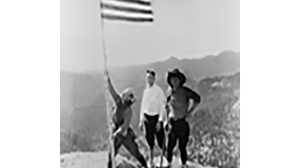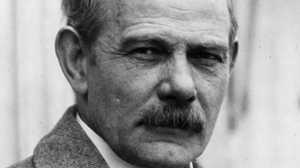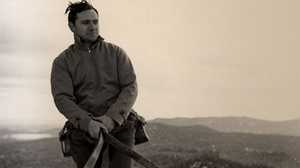Carving Mount Rushmore

1868
A treaty between the U.S. government and the native Sioux gives the Sioux property rights in perpetuity over a territory that includes the Black Hills.
1876
After gold is discovered in the Black Hills (1874), prospectors move in and displace the Sioux.
1885
Charles Rushmore goes to the Black Hills to inspect mining claims; Mount Rushmore is named in his honor.
1923
South Dakota state historian Doane Robinson writes to eminent Chicago sculptor Lorado Taft proposing that one of the "Needles" -- spiky rock formations -- of the Black Hills be carved in the likenesses of a "notable Sioux such as Red Cloud" and other Western figures. Taft responds by stating that he is in poor health.

1924
Robinson contacts Gutzon Borglum about the project; Borglum is enthusiastic. To arouse national interest, Borglum suggests George Washington and Abraham Lincoln as subjects.
1925
March 5: The Governor of South Dakota signs the Mount Harney bill, allowing for the carving of a monument in Custer State Park.
August: Borglum arrives in South Dakota and declares that he will carve a mountain, not the Needles. He decides on Mount Rushmore as the best site. Thomas Jefferson and Theodore Roosevelt are to be included in the sculptural program.
October 1: Rushmore is dedicated.
1927
President Calvin Coolidge spends a summer in the Black Hills.
August 10: A second dedication featuring Coolidge is arranged. Borglum invites Coolidge to write the text of the Entablature.
October 4: Actual carving begins.
1929
June 6: The Mount Rushmore National Memorial Commission is created. Rapid City mayor John Boland is named president of the Commission's executive committee.
1930
April: Borglum releases Coolidge's Entablature text -- with unlabeled "edits". Criticized by pundits, Coolidge withdraws from the entire scheme.
July 4: A dedication of the Washington head is held.

1931
Workers carving the Jefferson head encounter problems; the stone to Washington's right, where they have been working, is not strong enough to support the sculpture.
1933
Gutzon's son Lincoln Broglum begins full-time work at Rushmore.
A lot of stone is removed to find carveable rock to Washington's left; the area will be the new site for Jefferson. The old Jefferson head is blasted away.
1934
Coolidge having died the year before, Borglum announces in Hearst newspapers that text for the Entablature will be chosen from entries to a national contest; the challenge is to write a history of the U.S. in five hundred words. Hearst is to provide prizes. A young Nebraska man, William Burkett, wins the college age-group prize and a scholarship to college.
1935
Work on the monument continues. A surface on which to carve Roosevelt is found. Lincoln's portrait is situated where the Entablature was meant to be inscribed. Jefferson's lip is patched.
1936
Julian Spotts comes to Rushmore as a Park Service Engineer. He greatly improves the efficiency of the project's infrastructure.
August 30: President Franklin D. Roosevelt attends a dedication of the Jefferson head.
1937
A bill is introduced in Congress to carve a head of Susan B. Anthony on Rushmore. A rider on an appropriation bill requires that money be spent only on those figures already begun, thus ending the Anthony proposal.
September 17: The Lincoln head is dedicated.
1938
Work focuses on Roosevelt, with details of Washington's neck also being carved.
July: Excavation of the Hall of Recods begins.
The first Rushmore commission is disbanded. A new commission, hand-picked by Borglum, convenes on August 4.
1939
Rushmore comes under the jurisdiction of the Park Service again, in a general reorganization of government resources.
July 2: The Theodore Roosevelt head is dedicated. Special lighting effects are used to stage the dedication of the Roosevelt head.
Work on the Hall of Records is stopped because of the dangerous working conditions. Korczak Ziolkowski is hired as an assistant, but works there only 19 days, and leaves after a brawl with Lincoln Borglum. Ziolkowski will go on to carve a monument to Crazy Horse on another mountain in the Black Hills.
1941
March 6: Gutzon Borglum dies from complications from surgery.
Lincoln Borglum is asked by the Park Service to finish the heads.
October 31: Last day of carving.
1959
Mount Rushmore is the site of a climactic chase in Alfred Hitchcock's thriller, North by Northwest. The choice of Mount Rushmore stirs up controversy in South Dakota. Unable to secure permission to film on the mountain itself, Hitchcock and his team re-create the giant heads in a Hollywood studio. The scene will become one of the most famous in movie history.
1975
A bronze plate with Burkett's winning Entablature essay is erected at the site of Borglum's original studio.
1991
Mount Rushmore is officially dedicated by President George Bush.
1998
August 9: The Hall of Records is completed as a time-capsule with information about Mount Rushmore, Gutzon Borglum, and a history of the United States of America.
1999
The Park Service records over 2.6 million annual visitors to Rushmore, including tourists to Borglum's sculpting studio, a visitors' center, and a walking trail.








